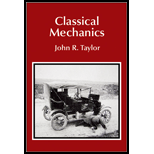
Concept explainers
(a)
The relation among the six lengths.
(a)
Answer to Problem 11.1P
The relation between the lengths is
Explanation of Solution
In the given case,
The net force acting on each of the springs is same in equilibrium position and each of the springs experiences either tension of compression. The restoring force of the spring is directly proportional to the compressed length according to Hooke’s law.
Here,
Rewrite equation (I) for the force acting on the first spring.
Here,
The compressed length of the first spring can be written as
Here,
Substituting equation (III) in equation (II).
Similarly, the equation for the restoring force on the second spring can be written as
Here,
And the equation for the restoring force on the third springs is
Here,
Conclusion:
The forcing acting on each of the spring is same at equilibrium. Hence equate equation (IV), (V) and (VI).
Therefore, the relation between the lengths is
(b)
The validity of the equation.
(b)
Answer to Problem 11.1P
The relations are proved.
Explanation of Solution
Two different forces act on the first cart. The extensive force of the first spring and the compressive force of the second spring.
Write the equation for the extensive force on the first cart.
Here,
Write the equation for the compressive force acting on the first cart by the second spring is,
Here,
Write the equation for the net force acting on the first cart suing Newton’s second law of motion.
Here,
The net force acting on the first cart is the vector sum of the forces
Substitute equation (VIII), (VII) and (VI) in equation (IX)
Consider the case of the case of the second cart. The forces acting on the second cart is the extensive force of the second spring and compressive force of the third spring.
Write the equation for the compressive acting on the second cart is,
Here,
Write the equation for the extensive force acting on the first cart by the second spring.
Here,
Write the equation for the net force acting on the second cart suing Newton’s second law of motion.
Here,
The net force acting on the second cart is
The negative sign indicates that the force
Substitute equation (XIII), (XII) and (XI) in equation (XIV).
Conclusion:
Therefore, the net force on first cart is
Want to see more full solutions like this?
Chapter 11 Solutions
Classical Mechanics
 College PhysicsPhysicsISBN:9781305952300Author:Raymond A. Serway, Chris VuillePublisher:Cengage Learning
College PhysicsPhysicsISBN:9781305952300Author:Raymond A. Serway, Chris VuillePublisher:Cengage Learning University Physics (14th Edition)PhysicsISBN:9780133969290Author:Hugh D. Young, Roger A. FreedmanPublisher:PEARSON
University Physics (14th Edition)PhysicsISBN:9780133969290Author:Hugh D. Young, Roger A. FreedmanPublisher:PEARSON Introduction To Quantum MechanicsPhysicsISBN:9781107189638Author:Griffiths, David J., Schroeter, Darrell F.Publisher:Cambridge University Press
Introduction To Quantum MechanicsPhysicsISBN:9781107189638Author:Griffiths, David J., Schroeter, Darrell F.Publisher:Cambridge University Press Physics for Scientists and EngineersPhysicsISBN:9781337553278Author:Raymond A. Serway, John W. JewettPublisher:Cengage Learning
Physics for Scientists and EngineersPhysicsISBN:9781337553278Author:Raymond A. Serway, John W. JewettPublisher:Cengage Learning Lecture- Tutorials for Introductory AstronomyPhysicsISBN:9780321820464Author:Edward E. Prather, Tim P. Slater, Jeff P. Adams, Gina BrissendenPublisher:Addison-Wesley
Lecture- Tutorials for Introductory AstronomyPhysicsISBN:9780321820464Author:Edward E. Prather, Tim P. Slater, Jeff P. Adams, Gina BrissendenPublisher:Addison-Wesley College Physics: A Strategic Approach (4th Editio...PhysicsISBN:9780134609034Author:Randall D. Knight (Professor Emeritus), Brian Jones, Stuart FieldPublisher:PEARSON
College Physics: A Strategic Approach (4th Editio...PhysicsISBN:9780134609034Author:Randall D. Knight (Professor Emeritus), Brian Jones, Stuart FieldPublisher:PEARSON





